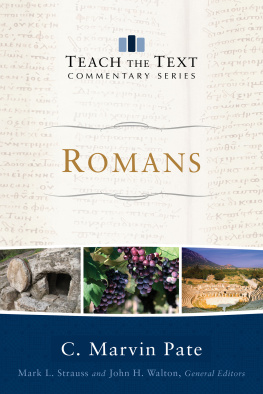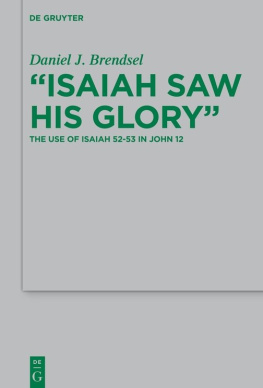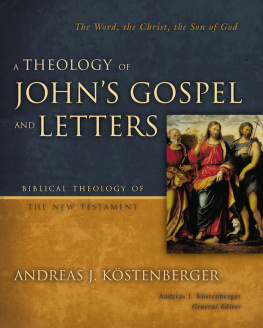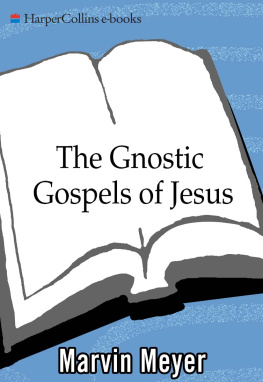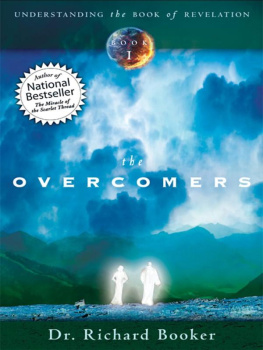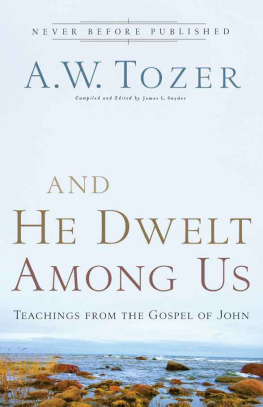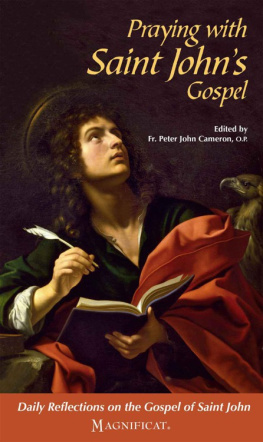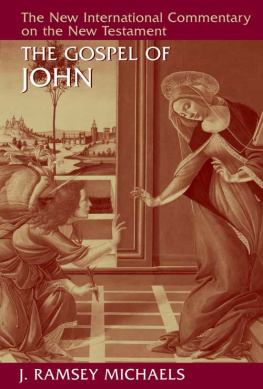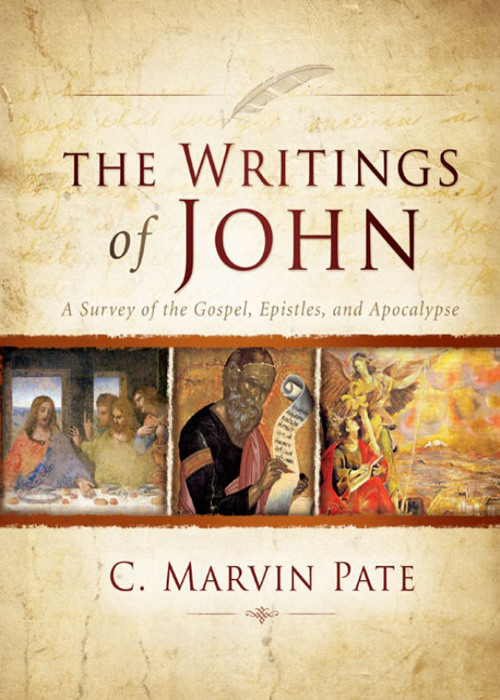THE W RITINGS
of J OHN
A Survey of the Gospel, Epistles, and Apocalypse
C. M ARVIN P ATE

CONTENTS
| AnBib An | alecta biblica |
| Ant. J | ewish Antiquities |
| AUSS | Andrews University Seminary Studies |
| CBQ | Catholic Biblical Quarterly |
| CD | Cairo Genizah copy of the Damascus Document |
| HTR | Harvard Theological Review |
| ICC | International Critical Commentary |
| JBL | Journal of Biblical Literature |
| JSNT | Journal for the Study of the New Testament |
| JSOT | Journal for the Study of the Old Testament |
| JSOTSup | Journal for the Study of the Old Testament: Supplement Series |
| J.W. J | ewish War |
| LCL | Loeb Classical Library |
| LXX S | eptuagint |
| Neot Ne | otestamentica |
| NICNT | New International Commentary on the New Testament |
| NIGTC | New International Greek Testament Commentary |
| NovTSup | Novum Testamentum Supplements |
| NTS | New Testament Studies |
| SBLDS | Society of Biblical Literature Dissertation Series |
| SNTSMS | Society for New Testament Studies Monograph Series |
| STB | Hermann L. Strack and Paul Billerbeck, Kommentar zum Neuen Testament aus Talmud und Midrash |
| TOTP | The Old Testament Pseudepigrapha |
| TV | Teologia y vida |
| WBC | Word Biblical Commentary |
| WUNT | Wissenschaftliche Untersuchungen zum Neuen Testament |
| ZNW | Zeitschrift fr die neutestamentliche Wissenschaft und die Kunde der lteren Kirche |
For the abbreviations of the Dead Sea Scrolls, see the list of Extrabiblical Writings.
DEAD SEA SCROLLS FROM QUMRAN
| Thanksgiving Hymns 1Q | H |
| Isaiah, copies a and b | 1QIsaab |
| War Scroll | 1QM |
| Commentary on Habakkuk 1Q | pHab |
| Rule of the Community 1Q | S |
| Rule of the Congregation 1Q | Sa |
| Florilegium | 4QFlor |
| Eschatological Midrashim | 4QMidrEschat |
| Miqsat Maaseh Ha-Torah 4Q | MMT |
| Prayer of Nabonidus 4Q | PrNab |
| Pseudo-Daniel | 4QpsDan arabc |
| Songs of the Sabbath 4Q | irabba-h |
| Testimonia | 4QTest |
| Geniza Damascus Document 6Q | D |
| Melchizedek Text 11 | QMelch |
| Psalms Scroll | 11QPsa |
| Temple Scroll | 11QTa,b |
OLD TESTAMENT APOCRYPHA
1Esdras
2Esdras Tobit Judith
The Additions to the Book of Esther Wisdom of Solomon
Ecclesiasticus, or the Wisdom of Jesus Son of Sirach Baruch
Letter of Jeremiah
Prayer of Azariah
Song of the Three Young Men
Susanna
Bel and the Dragon Prayer of Manasseh
1Maccabees
2Maccabees Psalm 151
OLD TESTAMENT PSEUDEPIGRAPHA
This list includes the most significant works and is not exhaustive.
2 Baruch
1 Enoch
4 Ezra (= 2 Esdras 3 14)
Book of Jubilees
Letter of Aristeas
Life of Adam and Eve
Psalms of Solomon
Sibylline Oracles
Testaments of the Twelve Patriarchs
3 Maccabees
4 Maccabees
Ascension of Isaiah
NEW TESTAMENT APOCRYPHA
This list includes well-known apocrypha apart from Nag Hammadi.
I.Gospels and Related Forms
A. Narrative Gospels and Acts
1.Gospel of the Hebrews
2.Gospel of Peter
3.Infancy Gospel of Thomas
4.Protevangelium of James
5.Acts of Paul (and Thecla)
II. Letters
A.Correspondence between Paul and Seneca
B.Pauls Letter to the Laodiceans
III. L iturgical Materials
A. Odes of Solomon
Welcome to the wonderful world of the writings of the apostle John! As we will soon see, evidence strongly indicates that John, the beloved disciple of Jesus Christ, wrote the fourth gospel, the epistles of John, and Revelationbooks scholars label the Johannine literature. Many interpreters of the Bible regard these works of John as the apex of divine revelation, and for good reason. The Christology (doctrine of Christ) of the Johannine literature is more exalted than that of any other biblical author. For John, Jesus Christ is God from eternity past (John 1:1 18), yet he is fully human in the present (so 1, 2, and 3 John). For the Beloved Disciple, Jesus is both the Lamb of Calvary (John 1:29, 36; 19) and the conquering Lion-Lamb of history (Rev. 6). Little wonder then that the later church councils drew heavily on Johns portrait of Jesus to craft their christological creeds, confessions that set in place the parameters of orthodoxy.
Johns eschatology is breathtaking, catapulting the blessings of the end times back into the present: the indwelling of the Holy Spirit, the new birth, eternal life, and much, much more. Johns soteriology (the doctrine of salvation) complements the preceding realized eschatology and is based on the substitutionary death of Christ on the cross. Such salvation is received by simple but genuine faith (John 20:30 31). Finally, we might also mention Johns ecclesiology, his doctrine of the church. For the Beloved Disciple, the followers of Jesus are both united with the story of Israel in the Old Testament and with the Trinity in the New Testament and beyond. Indeed, the spiritual union of the Christian with the triune God and his people is a Johannine teaching rivaled in the Bible only by Pauls inChrist mysticism. And on and on it goes with the magnificent themes Johns literature addresses, themes this textbook will discuss in some depth.
Introducing the work of any biblical author is a bit of a juggling act, balancing general, commonly accepted statements on the one hand with specific, analytical comments on the other hand. To emphasize only the former of these runs the risk of saying little more than nothing, while overemphasizing the latter will restrict the message of the biblical author to ivory-tower theologians. In this textbook, I have tried to strike the balance between the general and the technical by offering a thorough summary of the paragraphs comprising each of the three writings of John. User-friendly features, such as objectives, callouts, sidebars, photos, charts, review questions, and key terms, should make the more intense material engaging to the audience. This textbook divides naturally into three parts, each with its respective chapters: part 1: the Gospel of John; part 2: the Epistles of John; part 3: Revelation. This sequence reflects the generally accepted chronological order of the writing of Johns works.


